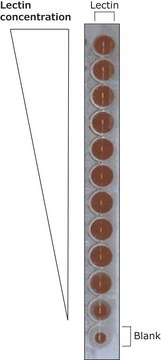A9460
Annexin V from human placenta
≥90% (SDS-PAGE), buffered aqueous solution
Sinónimos:
Annexin V, Calphosbindin I, Lipocortin V, PAP-1
About This Item
Productos recomendados
biological source
human placenta
Quality Level
assay
≥90% (SDS-PAGE)
form
buffered aqueous solution
mol wt
33 kDa (four subunits)
technique(s)
cell based assay: suitable
impurities
Human Source(HCV), tested negative
solubility
water: soluble
suitability
suitable for molecular biology
UniProt accession no.
shipped in
dry ice
storage temp.
−70°C
Gene Information
human ... ANXA5(308)
¿Está buscando productos similares? Visita Guía de comparación de productos
General description
Annexin V is a calcium-dependent phospholipid-binding protein. It is expressed in high concentration in cells with barrier functions, such as vascular endothelium, epithelial cells in bile ducts, placental trophoblasts, mammary ducts, renal tubules, and nasal epithelium.
Application
- to verify the involvement of phosphatidylserine in adhesion using flow cytometry
- to test adhesion specificity of phosphatidylserine
- for synthesis of NIR700-Annexin-V imaging probe
- in dynamic light scattering (DLS) assay to test the effects of various treatments on virion aggregation
Biochem/physiol Actions
Packaging
Physical form
Storage Class
12 - Non Combustible Liquids
wgk_germany
WGK 2
flash_point_f
Not applicable
flash_point_c
Not applicable
Certificados de análisis (COA)
Busque Certificados de análisis (COA) introduciendo el número de lote del producto. Los números de lote se encuentran en la etiqueta del producto después de las palabras «Lot» o «Batch»
¿Ya tiene este producto?
Encuentre la documentación para los productos que ha comprado recientemente en la Biblioteca de documentos.
Nuestro equipo de científicos tiene experiencia en todas las áreas de investigación: Ciencias de la vida, Ciencia de los materiales, Síntesis química, Cromatografía, Analítica y muchas otras.
Póngase en contacto con el Servicio técnico



